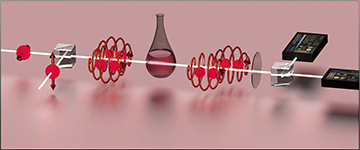![]()
Marta Mellini, Ilaria Gianani, Giordano Rampioni and Marco Sbroscia were among the members of a team at the Università degli Studi Roma Tre, Rome, that explored the use of quantum light to enable real-time, accurate measurement of enzyme activity. [Image: Simonetta Pieroni]
As the sensitivity and reach of their experiments has increased, biologists have faced a growing quandary. They’d like to follow the behavior of biomolecules, especially enzymes, in real time. But boosting light to the levels required to optically snoop on these intricate molecules risks changing their behavior—or even damaging them.
A team from Italy’s Università degli Studi Roma Tre in Rome now proposes opening a quantum-sensing window into these delicate maneuvers (Opt. Express, doi: 10.1364/OE.27.035245). By taking advantage of light’s quantum characteristics, the researchers’ approach could dramatically reduce the photon budget necessary to track enzyme activity, affording new opportunities to catch these key biomolecules in the act.
Biological catalysts
Enzymes are biocatalysts responsible for engineering the rate, or kinetics, of chemical reactions throughout living systems. In principle, these catalysts can be studied through a variety of optical techniques—particularly via changes in molecular chirality, or “handedness,” that can be probed using circularly polarized light. But in practice, intense light, as from laser imaging, can alter the enzymatic activity owing to thermal or electrical-field effects, resulting in a useless measurement. Make the light levels too low, on the other hand, and the signal from the molecule is apt to be swamped by noise and the measurement precision eroded.
The Italian team, led by Ilaria Gianani, looked to tackle the problem by engineering quantum control into the illuminating light. The ability to control and manipulate light at the single-photon level, they reasoned, would keep potential damage to or interference with the enzymes minimal—and would also open up avenues for improving the signal-to-noise ratio by tweaking the details of quantum uncertainty.
High N00N
To put the idea to the test, the team focused on the activity of invertase—an enzyme responsible for hydrolyzing the disaccharide sugar sucrose into two monosaccharides, d-glucose and d-fructose, that the cell can metabolize. By breaking down the sucrose in this way, the enzyme’s activity results in changes in the chirality (the left- or right-handed sense of twist) of the ensemble of molecules. That, in turn, changes the local refractive index felt by right- or left-circularly polarized light, which can be measured by phase offsets between light of the two polarizations. (Indeed, the very name “invertase” for the enzyme came from the change in optical properties in a sugar solution after the enzyme had gone to work on it.)
The researchers’ quantum approach to measuring these changes relies on creating a state of light called a N00N state. Such a multi-photon state is a coherent superposition of two possible events: all photons are either in right-circular polarization or in left-circular polarization. Taking advantage of the “quantum weirdness” of superposition, this allows a single, superposed state of a handful of photons to probe both polarizations at the same time, driving quantum uncertainty down to a minimum value possible for the number of photons available.
Real-time tracking
A schematic of the team’s experimental setup. [Image: Cimini et al., Opt. Express, doi: 10.1364/OE.27.035245] [Enlarge image]
The team put together a setup to test out the concept of using N00N states to measure enzyme activity. In the setup, single photons with orthogonal polarizations, produced via spontaneous parametric down-conversion, are interfered in a polarizing beam splitter, an action that makes the photons indistinguishable in their spatial and temporal degrees of freedom and creates a N00N state in their circular-polarization basis.
With the photons in this superposed state, they next pass into a solution in which the invertase enzyme is actively hydrolyzing dissolved sucrose, leading to a change in the mix of molecular chiralities in the solution. The interaction of the light with the sugar creates a phase shift between the two components of the N00N state. The phase shift—which, owing to the chirality changes, depends directly on the amount of sucrose that’s been processed by invertase enzyme—is then read at the end via two avalanche photodiodes, after processing through another PBS.
Testing the setup on actual reagents with known initial conditions and kinetics, the team found that it was able to track the changes in chirality, and thus the enzyme’s activity, in real time using the setup.
Interdisciplinary team
The researchers stress that their setup offers only a proof of principle, and that a number of obstacles—for example, getting detectors of adequate quantum yield—remain to be overcome given the low photon numbers involved. Addressing those issues could, the team believes, ultimately lead to a system for state-of-the-art tracking of enzyme activity.
Getting there, the researchers stress, will require cross-disciplinary work among biologists and quantum physicists. That’s a foundation on which the team’s success has already relied, team leader Gianani noted in a press release. “Although it was difficult to exchange ideas at first,” she said, “the team eventually grew together and developed a shared language that helped the work progress smoothly.”

